Hunley Submarine Tour
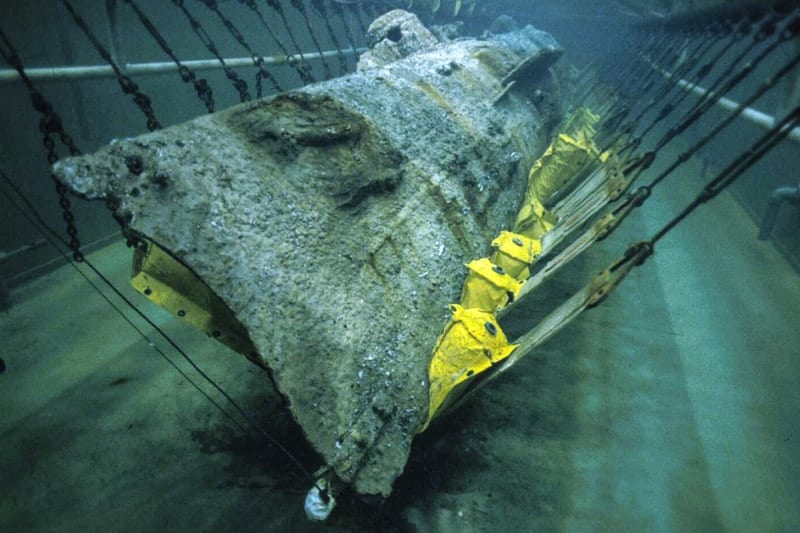
On February 17th, 1864, the H. L. Hunley became the first successful combat submarine in world history with the sinking of the USS Housatonic. After completing her mission, she mysteriously vanished and remained lost at sea for over a century. For decades, adventurers searched for the legendary submarine. On February 17th, 1864, the H. L. Hunley became the first successful combat submarine in world history with the sinking of the USS Housatonic. After completing her mission, she mysteriously vanished and remained lost at sea for over a century. For decades, adventurers searched for the legendary submarine.
Over a century later, the National Underwater and Marine Agency (NUMA), led by New York Times-bestselling author Clive Cussler, finally found the Hunley in 1995. News of the discovery traveled quickly around the world. A ground breaking effort began to retrieve the fragile submarine from the sea. The Hunley Commission and Friends of the Hunley, a non-profit group charged with raising funds in support of the vessel, led an effort with the United States Navy that culminated on August 8th, 2000 with the Hunley’s safe recovery.
She was then delivered to the Warren Lasch Conservation Center, a high-tech lab specifically designed to conserve the vessel and unlock the mystery of her disappearance. The Hunley has since been excavated and proved to be a time capsule, holding a wide array of artifacts that can teach us about life during the American Civil War. The submarine and the hundreds of artifacts found onboard are currently undergoing preservation work while archaeologists use the historical clues they have found to piece together the final moments of the Hunley and her crew.
The Hunley’s journey through time has been marked by innovation, courage and tragedy. Her against-all-odds tale has spanned the centuries and is one of the greatest maritime mysteries in recent history. This website follows the pioneering vessel from her inception during the American Civil War to the modern-day efforts surrounding her preservation and study.
Fort Sumter Tours
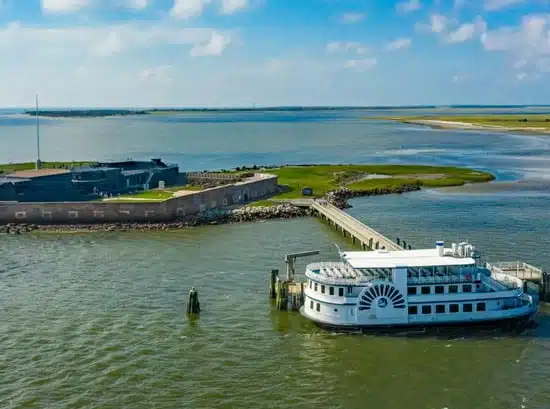
ACCESSIBILITY LIMITATIONS AT FORT SUMTERVisitors must use a flight of steps to travel between the boat and the Fort due to rehabilitation work on the Fort Sumter Dock. There is no ramp. We apologize for the inconvenience.
Fort Sumter Tours is the only authorized concessioner for the National Park Service and actually docks at Fort Sumter. Fort Sumter Tours offers year round trips to Fort Sumter that departs daily from Liberty Square in Charleston (340 Concord Street) and Patriots Point in Mount Pleasant (40 Patriots Point Rd). On the ferry ride to and from the fort, visitors will enjoy spectacular views of Charleston’s famous Battery with its antebellum mansions, the Arthur Ravenel, Jr. Bridge, Castle Pinckney, the USS Yorktown, dolphins and more.
Tour Tips:
- Please arrive 30 minutes early for ticketing and boarding
- Please call with accessibility questions
- Note: Tours leave promptly at scheduled tour time
- Total tour time is 2 hours and 15 minutes
- Includes approximately 1 hour of a self-guided Fort tour
Drayton Hall
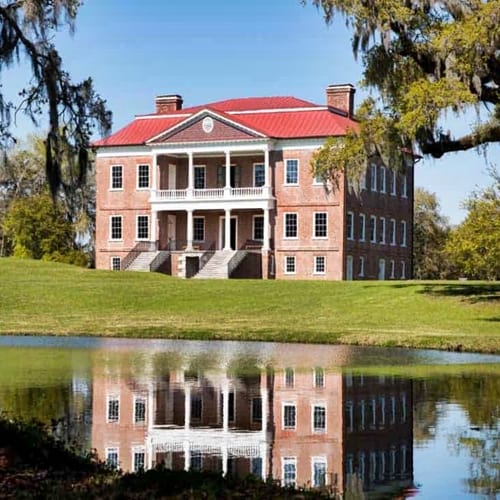
NOTICE:
The entrance gate closes at 3.30 pm daily and the exit gate closes at 5:00 pm daily. Drayton Hall asks that you arrive by 1:45 pm to complete the audio tour.
Founded in 1738, Drayton Hall is the earliest example (in the USA) of fully executed Palladian architecture and the oldest preserved plantation house in America still open to the public. Because of our preservation philosophy, all imperfections and changes over time have survived to the present.
WHAT IS INCLUDED:
- Self-paced Audio House Tour: Offered daily from 9:00am-1:45pm. The main house tour is an audio tour, please bring earphones or earbuds. Interpreters are stationed in the house to answer questions.
- African American Cemetery: Drayton Hall’s African American Cemetery is one of the oldest documented African American cemeteries in the nation still in use. The earliest surviving record describes its use as a “burying ground” and dates from about 1790, indicating this sacred ground may be even older. In keeping with the wishes of Richmond Bowens, a descendant of the enslaved at Drayton Hall, the cemetery has been “left natural,” not manicured or planted with grass or decorative shrubs.
- Self-guided nature walks: See layers of history carefully preserved on the 125 acres that surround the main house: the central axis and clear view to the Ashley River, planned by John Drayton over 265 years ago; Richmond Bowens’ camellia; the reflecting pond; the site of the former garden house or the 18th-century live oaks which continue to provide the structure to the Drayton estate.
- Museum Shop: From high-end art reproductions to pieces inspired by the Drayton Family’s extensive porcelain collection to local food favorites, The Shop at Drayton Hall has something special for each and every one of our visitors.
- Lenhardt Garden: The garden’s plantings are historically inspired, with horticultural specimens related to John Drayton’s botanical lists. The courtyard has a selection of benches to best enjoy the seasonal flora and fauna.
- Caretaker’s House: The exhibit in the caretaker’s house highlights the post-Civil War period and the 20th century at Drayton Hall. Learn about the African American community that formed because of the phosphate mining industry and kept the property alive for 100 years after the Civil War. Constructed in 1870, the caretaker’s house was built for a caretaker to watch over the main house and grounds while phosphate was mined on the property. The house has been rehabilitated to serve as a conditioned exhibit space, creating opportunities to see layers of its construction and decorative materials.
- The Gates Gallery: Drayton Hall Preservation Trust’s collections are on public display at the estate for the first time in history. The Gates Gallery includes rotating exhibitions of decorative arts objects that once belonged to the Drayton family, archaeological artifacts related to the estate and its inhabitants, as well as archival materials and architectural fragments.
Aiken-Rhett House Museum
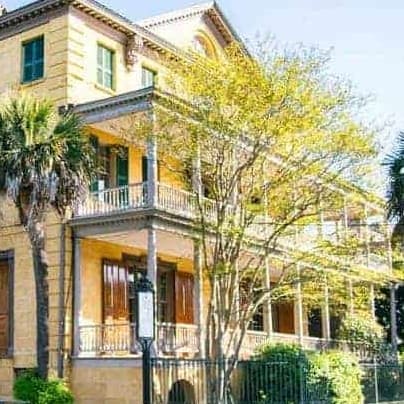
Self-guided tours. Last tour begins at 4:15 p.m.
History of the House
Built in 1820 by merchant John Robinson, the Aiken-Rhett House is nationally significant as one of the best-preserved townhouse complexes in the nation. Vastly expanded by Governor and Mrs. William Aiken, Jr. in the 1830s and again in the 1850s, the house and its outbuildings include a kitchen, the original slave quarters, carriage block and back lot. The house and its surviving furnishings offer a compelling portrait of urban life in antebellum Charleston, as well as a Southern politician, slaveholder and industrialist. The house spent 142 years in the Aiken family’s hands before being sold to the Charleston Museum and opened as a museum house in 1975.
When the Foundation assumed ownership in 1995, we adopted a preserved-as-found preservation approach, meaning the structure and contents are left in an “as-found” state, including furniture, architecture and finishes that have not been altered since the mid 19th century. The only restored room in the house, the art gallery, showcases paintings and sculpture the Aiken family acquired on their European Grand Tour.
While many dependency buildings in Charleston have been demolished or adapted, the Aiken-Rhett slave quarters – with their original paint, floors and fixtures – survive virtually untouched since the 1850s, allowing visitors the unique chance to better comprehend the every-day realities of the enslaved Africans who lived on-site, maintained the household and catered to the needs of the Aiken family and their guests.
Haunted Yorktown Tour
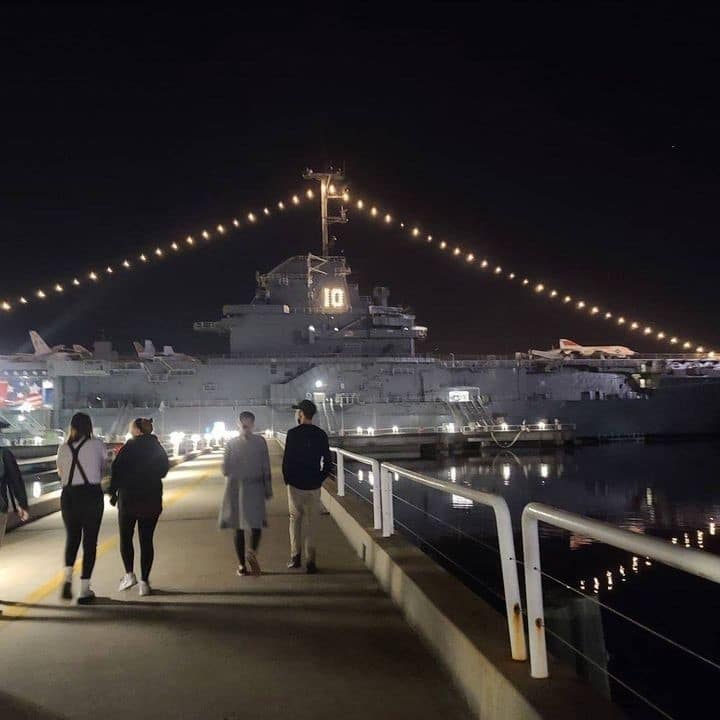
- Maritime Superstitions
- Unusual Ship Christening
- Captain Jocko Clark
- Smokey Stover
- Mysterious Sailor Disappearance
The USS Yorktown Ghost Tours meet at 40 Patriots Point Rd in Mt. Pleasant. All tours meet at the booth located right inside the admission gate 15 minutes prior to tour time.
Harbor Tour by SpiritLine Cruises
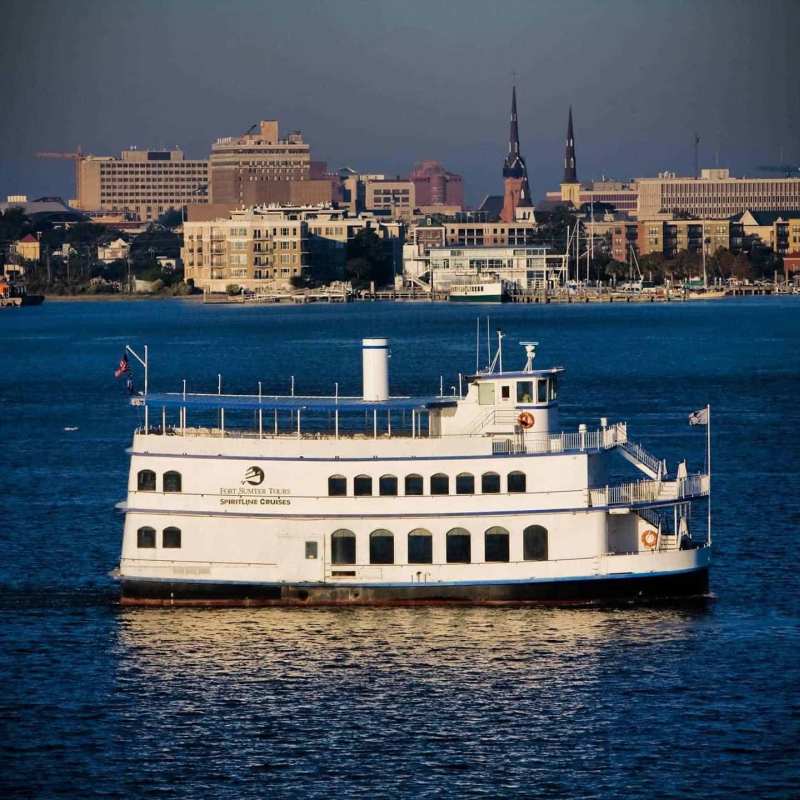
This Charleston Harbor Tour by SpiritLine Cruises offers visitors Live Narration by a Licensed City Tour Guide. What does that mean? You will learn fascinating historically accurate Charleston history while you cruise the gentle waves of her harbor. Our knowledgeable and entertaining tour guides are licensed by the City of Charleston and enjoy interacting with guests. You will see notable American landmarks, such as Fort Sumter, the aircraft carrier USS Yorktown, The Battery, the Ravenel Bridge, Castle Pinckney and other sites from the past and present.
This relaxing and fun tour departs from two locations daily. You will hear enthralling tales of the city’s colorful past as well as scintillating facts about her most-interesting former citizens. Perfect for all ages, the whole family can enjoy cruising along the coastline of our beautiful “Holy City”. Do you know why we call it the “Holy City”? Find out on this 90-minute Charleston Harbor tour.
Tour departs from two locations:
1.) Downtown Charleston: the dock to the left of the Aquarium.2.) Patriots Point in Mount Pleasant. Look for the SpiritLine signage, go to ticket window and check-in.
Calhoun Square
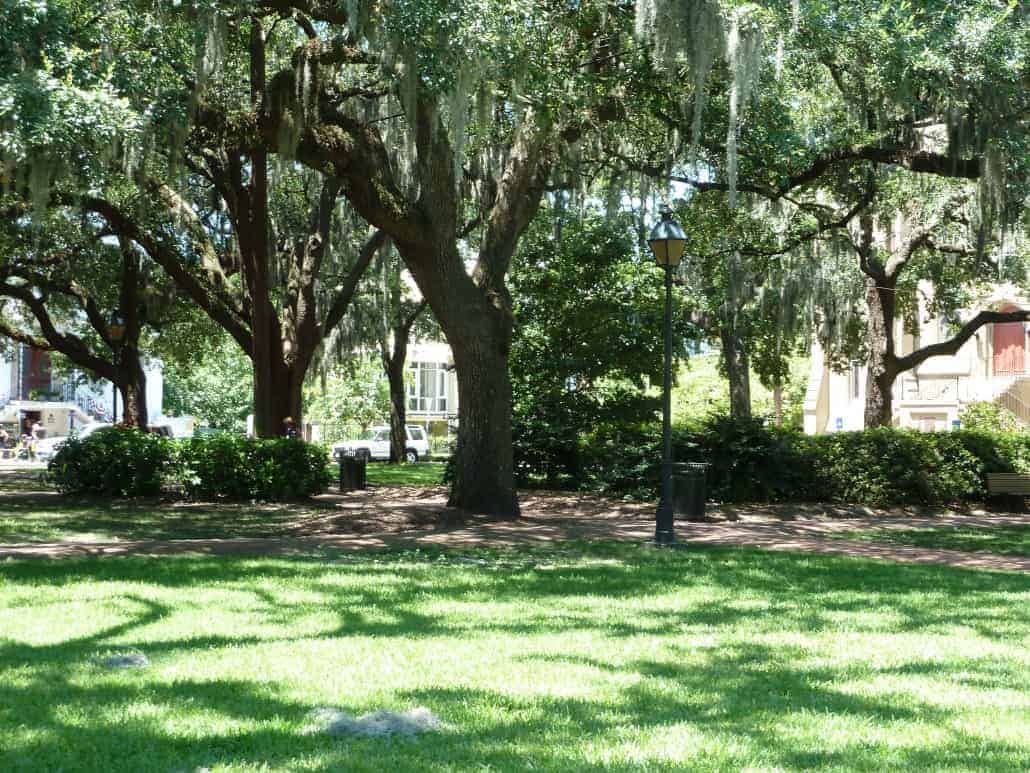
This square was named for John C. Calhoun,“the Great Orator of the South,” and laid out in 1851. Calhoun was a South Carolina native who served as vice president, secretary of state and secretary of war. The square is home to many beautiful homes built in the Greek Revival style.
- Wesley Monumental United Methodist Church is on Calhoun Square and is considered to be one of the most beautiful Methodist churches in the South. Built in 1868 as a memorial to John Wesley and his brother Charles, the Gothic Revival church was inspired by Queen’s Kirk in Amsterdam, Holland. John Wesley is revered as the founder of the Methodist Church; however few remember that his brother Charles Wesley wrote the words to nearly 6,000 Christian hymns, including the classic “Hark! The Herald Angels Sing.” Because funds were raised to build the church from all over the world, the iconic structure is said to be the home church of all Methodists.
- Massie Heritage Center – The center was established following the death of Peter Massie in 1841. He left a bequest of $5,000 for the establishment of a school for the poor in Savannah. The Massie School is Georgia’s oldest in continuous operation, having operated as a public school until 1974 and now serving as a resource center for living history. The center’s collection includes a variety of period costumes and exhibits on state and local history, as well as on historic preservation. An outstanding example of Greek Revival architecture, the building itself was completed in 1856 and dedicated to the education of poor children. It remains an architectural treasure, with period features such as a gable roof, wooden cupola and cornice, and a unique connecting passageway.
Madison Square
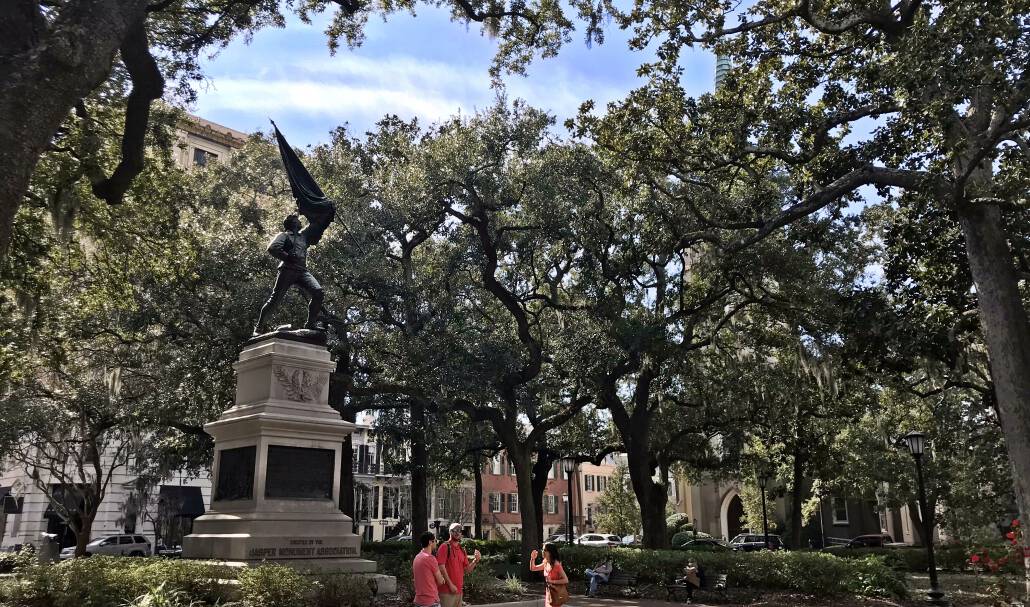
Madison Square was laid out in 1837 and named for the fourth president of the United States, James Madison. There is a large monument dedicated to native Savannahian Sgt. William Jasper in the center of the square, in memory of heroism during the Revolutionary War. At the southern margin of the square, two cannons are featured, marking the starting points of Georgia’s first two highways.
- Savannah College of Art & Design – (south side of the square) – In the spring of 1979, The Savannah College of Art and Design purchased and renovated the Savannah Volunteer Guard Armory in Madison Square to serve as the school’s first classroom and administration building. Today, SCAD, as it is known, is one of the largest art and design universities in the world.
- The Sorrel-Weed House (northwest corner of the square) is famous not only for its dazzling architecture but also due to its reputation as the most haunted house in America. The Greek Revival structure was built in 1841 for Frances Sorrel, a merchant from the West Indies. The story is told that Sorrel’s wife jumped to her death from the second floor balcony after learning that Francis was having an affair with a slave girl. The girl was found hanged two weeks after Mrs. Sorrel’s suicide. An episode of the popular TV show “Ghost Hunters” explored the home in depth. The ghost hunters claimed to have captured an African-American woman screaming in the second floor bedroom where the hanging supposedly occurred. The basement of the home once housed the home’s slaves and contained the kitchen facilities where many of the slaves toiled, unseen by those above. Ghost stories aside, the property has great historical significance. It was once home to Brig. Gen. Moxley Sorrel, the youngest general officer in the Confederate army. Sorrel served as a staff officer to Lt. Gen. James Longstreet and was decorated for heroism at the Battle of the Wilderness in May 1864. Additionally, Robert E. Lee visited the home in 1861 before being appointed to command the Army of Northern Virginia the following year. In 1953, the Sorrel-Weed House was the first house in Georgia to be designated a state landmark. The home is also a National Trust Historic Landmark and is currently operated as a bed and breakfast. The home is available to the public for tours.
- Green-Meldrim House – (west side of the square) This house is one of the nation’s best examples of Gothic Revival architecture and has great historic significance due to its use as headquarters by Gen. William T. Sherman during his occupation of Savannah. The home was built for Charles Green, who came to Savannah from England in 1833 and made a fortune in the cotton trade. In hopes of sparing his new and elaborately constructed home from pillaging by Union troops, Green rode out to meet Gen. Sherman and offered his house as headquarters for the Union forces. The story is recounted in Sherman’s own memoirs: “While waiting there, an English gentlemen, Mr. Charles Green, came and said that he had a fine house completely furnished, for which he had no use, and offered it as headquarters. He explained, moreover, that Gen. Howard had informed him, the day before, that I would want his house for headquarters. At first I strong disinclined to make use of any private dwelling, lest complaints should arise of damage and loss of furniture and so expressed myself to Mr. Green; but, after riding about the city and finding his house so spacious, so convenient, with large yard and stabling, I accepted his offer and occupied that house during our stay in Savannah. He only reserved for himself the use of a couple of rooms above the dining room, and we had all else, and a most excellent house it was in all respects.” – Gen. William T. Sherman The home remained in the possession of the Green family until its sale in 1892 to Judge Peter Meldrim, a former Savannah mayor and past president of the American Bar Association. In 1943 the Green-Meldrim House was sold once again, this time to St. John’s Episcopal Church, and the building now serves as the rectory for the church. The church has graciously made the home available to the public for daily tours.
- St. John’s Episcopal Church was built in 1852 in the Neogothic style and is well-known for its lovely stained glass windows. A nod to the city’s seafaring heritage, a ship’s mast is located in the center of its only spire. The church’s leaders preached unsuccessfully against secession before the Civil War, and so it is fitting that Sherman’s old headquarters, the Green-Meldrim House, now serves as the parish house.
Monterey Square
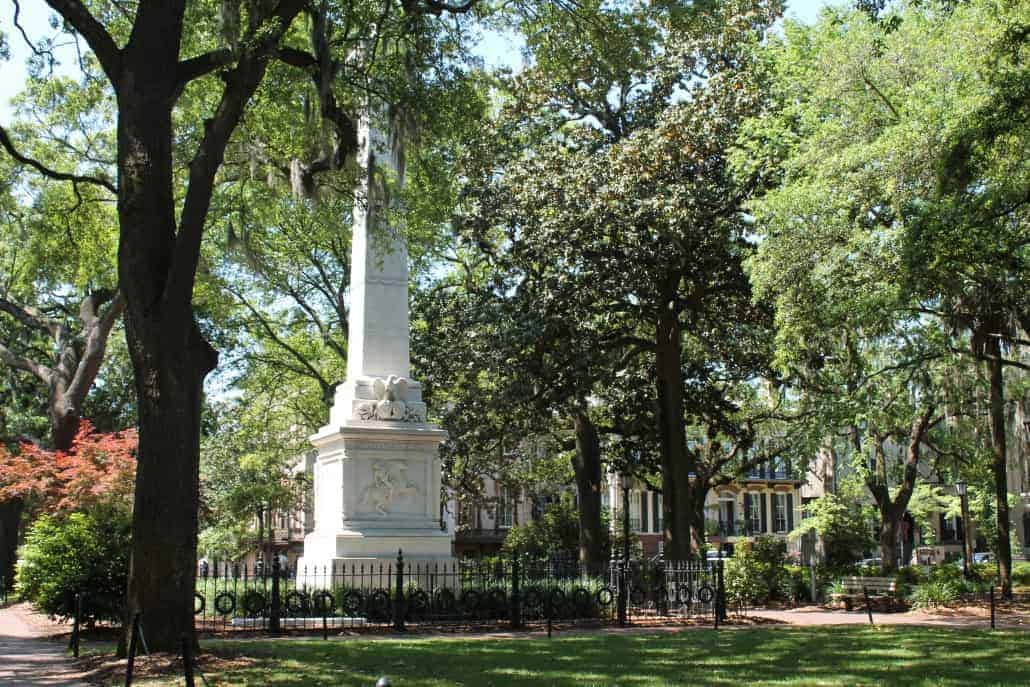
The square was laid out in 1847 and named to celebrate a notable victory of the Mexican-American War, the capture of the city of Monterrey, Mexico, in 1846.
- Pulaski Monument – The center of the square is home to a monument built for Count Casimir Pulaski, who lost his life fighting during the Siege of Savannah in 1779.
- Mercer-Williams House – (To the left or west side of square) – Monterey Square is probably most famous these days as the home of the Mercer-Williams House, owned by Jim Williams, lead character in the book “Midnight in the Garden of Good and Evil,” which later became a major motion picture starring John Cusack and Kevin Spacey. The book chronicled the true story of an infamous Savannah murder trial and mentioned the real names of many Savannah citizens who were involved in the case. Much of the action in the book, including the killing of Danny Hansford in May 1981, took place in a home on the west side of Monterey Square, at 429 Bull Street. Construction began on the Mercer-Williams House in 1860 but was not completed until 1871. Hugh Mercer, the original builder, was the uncle of the composer Johnny Mercer, but none of the family ever occupied the home. Jim Williams’ sister currently owns the home and has turned it into a museum that offers daily tours. To the immediate right of the Mercer-Williams House stands the home of Lee and Emma Adler, who were also featured in the book.
- Temple Mickve Israel – This magnificent synagogue was designed by nationally known New York architect Henry G. Harrison and built in the 1870s in the Neogothic style. Although the building itself dates back to the Victorian Era, the congregation can trace its roots to 42 Jews who arrived in Savannah on July 11, 1733, just five months after Gen. James Edward Oglethorpe established the colony of Georgia. This was the largest group of Jews to settle anywhere in North America during Colonial times. Today, Temple Mickve Israel stands as a tribute to the hard work and perseverance of the early Jewish colonists who established the first synagogue in Georgia. It is also the only synagogue in the United States to have been built in the Neogothic style and is an outstanding example of that architectural movement. Content composed with the HTML code editor with live preview . Get a subscription to remove promotional messages or browse our directory for the best free online tools.
Savannah Square Pops
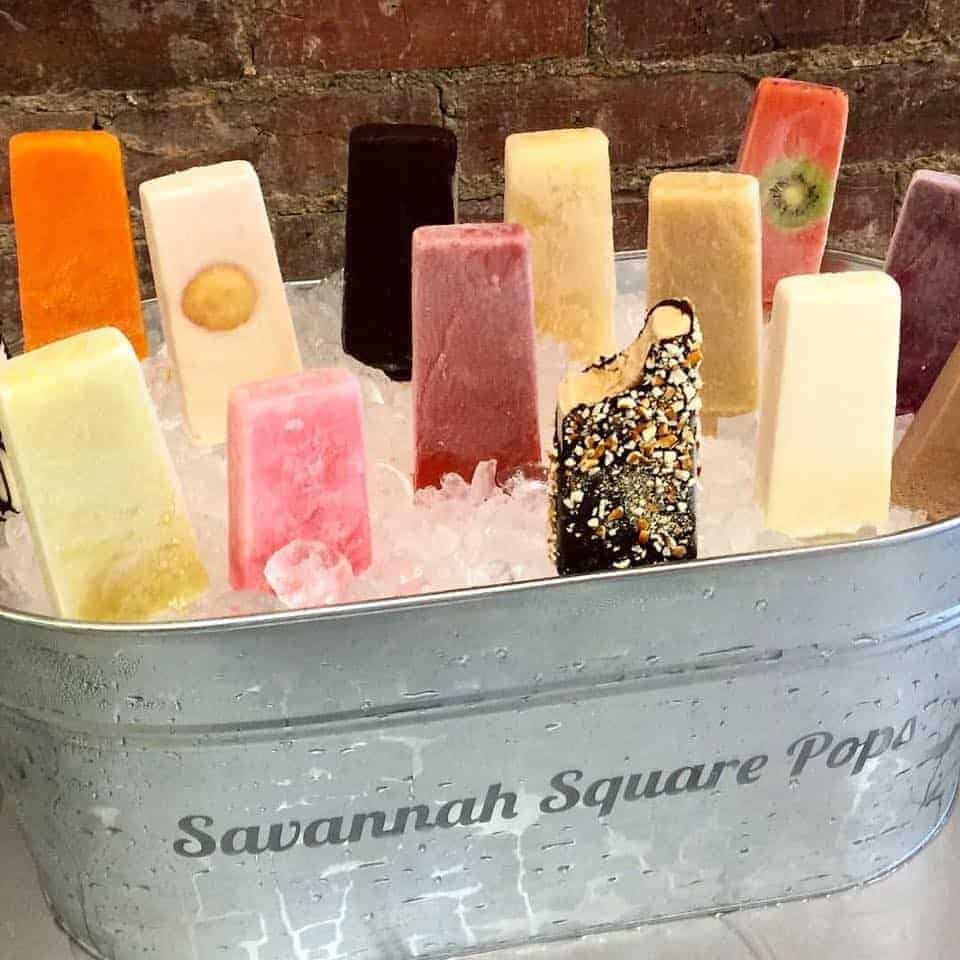
Treat yourself to a gourmet popsicle from this fun and one-of-a-kind shop. Featured by Duff Goldman (Food Network Chef, Ace of Cakes) as one of his favorite sweet treats in the nation!
Each of their pops are named after the one of the 22 historic Savannah squares. Some fan favorites are Calhoun Square (Blackberry Lemonade), Franklin Square (Strawberry Balsamic) and Pulaski Square (Salted Caramel, dipped in dark chocolate and rolled in pretzel pieces). Their philosophy on ingredients is to use the best and the least. The Key Lime Pie Pop has the most ingredients, with fresh squeezed lime juice, fresh heavy cream, buttermilk, milk, graham crackers, raw cane sugar, and Sea Salt. Extra care is given to several of their pops to make them as beautiful as they are delicious. The Telfair Square Pop, for example, features a whole Oreo embedded in the side, and the Wright Square pop showcases a perfect slice of kiwi. This isn’t easy to do, but it’s part of that extra mile They go to make the product special.

